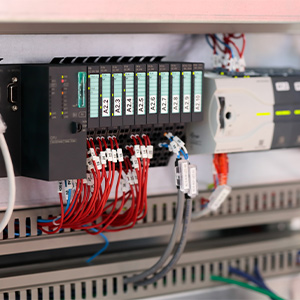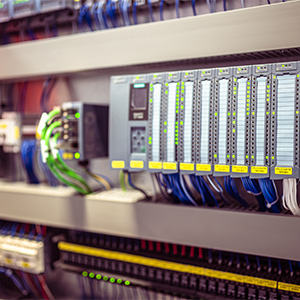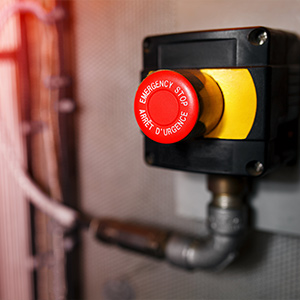At Rowse Automation, we stock a wide variety of control cables that you might need when wiring your control panels and automated systems. However, not everyone is familiar with Control Panel Wiring Colour Codes or the standards that govern them, so the following information should be helpful.
Standards
It's always important when dealing with any type of dangerous item to have agreed rules of engagement. Electricity can pose a serious safety risk if it's not handled properly, so a degree of standardisation is essential. For this reason, government authorities and international institutions draw up codes for all aspects of electrical installation, covering equipment, components and machinery. In Europe, these are called EN (European Norm) codes, which are usually drawn up to comply with ISO standards.
Electrical wiring is also part of this framework, and in the EU the colour coding is also governed by a set of European Commission directives, called EN codes. These were originally based on the British standards set out in BS 7671, and were concerned with domestic circuits and older types of static installation. However, these standards were drawn up long before the arrival of complex automated systems, and the EN codes superseded the original British Standards in order to cover a much wider range of operations. The international standard EN 60204-1 was specifically designed to govern Control Panel Wiring Colour Codes.
Control Panel Wiring Colour Codes
The required safety standards for wiring an electrical enclosure are set out in EN 60204-1 (Safety of Machinery – Electrical Requirements of Machines). This regulation also designates the colour and type of cable to use. A revised standard called IEC 60445:2017, issued by the International Electrical Commission (IEC), also covers the safety principles governing HMI terminals. These include the identification and marking of conductors, conductor terminations and equipment terminals.
Control Panel Wiring Colour Codes As Set Out In EN 60204-1
Which cable colour you choose for your installation depends initially on the type of circuit you have, and whether it's AC or DC voltage.
AC and DC Power Circuits
| AC Phase and DC + - | Black |
| AC Neutral | Light Blue |
| Protective Conductor (Earth) | Green and Yellow |
AC and DC Control Circuits
| AC Live or Neutral via transformer | Red |
| AC Neutral (mains) | Light Blue |
| DC+ - | Blue |
| Earth | Green and Yellow |
| Interlocks control circuits supplied from an external power source or remote panel | Orange |
Panel Services Colour Coding (multicore)
| AC Live or Neutral cores | Orange |
| Earth cores | Green and Yellow |
| Sheath | Orange |
Panel Services Colour Coding (single core)
| Type of Circuit | Colour |
|---|---|
| AC Live | Orange |
| AC Neutral | Light Blue |
| Earth | Green and Yellow |
Protective Conductor Or Earth
The type of wire used to designate the protective conductor (earth) cable must always be GREEN-AND-YELLOW. This combination of colours has been specifically reserved to designate the protective earth cable, and the colours must be sustained throughout the entire length of the wire.
If the earth wire is of an insulated variety, the GREEN-AND-YELLOW colour combination must be distributed in a 70/30 ratio over the entire surface area of the wiring, and clearly visible in any 15mm length. This type of wire is usually found as a GREEN background with a YELLOW stripe.
In certain circumstances, it is permissible for the GREEN-AND-YELLOW colour coding to be shown only in limited locations. This applies when the wiring is installed somewhere that's not easily accessible, or where the wire can clearly be identified as the protective earth. In these situations, the GREEN-AND-YELLOW colour coding can be shown on the ends of the conductor, or where it's visible in any accessible location of the wiring.
Neither GREEN nor YELLOW Control Panel Wiring should ever be used separately if there is even the remotest possibility of confusing these colours with the GREEN-AND-YELLOW combination wire used to designate the protective earth.
Neutral
The colour specified for designating neutral conductor wire is LIGHT BLUE. In order to avoid any possibility of confusion between the neutral conductor wire and wires of any other type, the LIGHT BLUE colour should be used only for the neutral wire, and not for any other type of wiring function or associated cables. The LIGHT BLUE colour should be sustained throughout the neutral conductor's entire length, unless the wiring is being installed in a concealed or limited access location. In these circumstances, the neutral conductor wire can be identified using a LIGHT BLUE stripe of 15-100mm width.
Tri-Rated Cable
Tri-Rated Cable is an increasingly popular choice for control panels that are used in association with power switchgear, including instrumentation, switch and relay panels and electrical cabinets. It's also known as Tri-Rated Single wire (TRS), switchgear cable or control panel wire, and it comes in many different colours. Rated and standardised under BS 6231, this kind of fire retardant cable is specifically designed to offer resistance to high temperatures. Tri-Rated Cable is capable of functioning in temperatures up to a maximum of 105ºC. However, BS 6231 stipulates that for reasons of safety, the maximum operating temperature should not be more than 90ºC. This wire is flexible, with one layer of PVC heat-resistant insulation around a single core of copper strands.
The name Tri-Rated Cable means that it's rated according to the official standards of North America and Canada as well as Europe. The cable owes its popularity to this triple rating, making it safe for use in many countries that comply with these standards. The voltage rating does differ, however, between the three bodies. The BS 6231 standard stipulates a voltage rating of 1000V for the Tri-Rated Cable, while the Canadian and US standards stipulate a rating of only 600V.
The huge bonus conferred by the triple rating means that wiring panel designs can be uniform across a much wider range of markets, so manufacturing processes can also be a great deal more flexible. Tri-Rated Cable can be used in small electrical devices, and functions as an internal connector in such items as motor starters, controllers and rectifier equipment.




